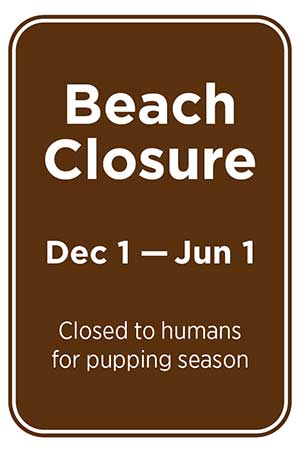people and community
we tread lightly to give baby seals safe harbor
2 min read | june 30, 2023
Seals lounge on the rocks at the beach in Carpinteria, California.
When it comes to leaving local wildlife alone, Chevron gets the seal of approval.
For the past six years, our team in Carpinteria, on California’s Central Coast, has worked with a group of community volunteers to avoid disturbing a harbor seal nursery, known as a rookery. This year, almost 60 seal pups were born and called the Carpinteria beach home for their first few months of life.
why it matters
Noise, people and lights are just some of the things that can disturb the seals when they’re on the beach. If mother seals are frightened away, young seals may be left behind. This threatens their chances of survival, especially if they are not reunited with their moms.
the big picture
In Carpinteria, we are doing the prep work to dismantle an onshore gas plant and its pipes in the area. It was once connected to now inactive offshore oil platforms. Chevron and other companies use the pier adjacent to the rookery, resulting in vessel and truck traffic.
When finished, the decommissioning will have completely removed the plant and pipelines onshore and remediated the soil.
The rookery has been on this beach for more than 30 years. During pupping season from December 1 to June 1, when seals are giving birth and nurturing their young, the city of Carpinteria closes the beach to humans.

what we’re doing
Kevin Duganne, site manager at the Carpinteria gas plant, noted that education is key in helping protect the seals. His team maintains an open line of communication with volunteers, addressing any concerns that may arise and coaching team members on how to safely work around the seals and pups.
Volunteers monitor the seals from a nearby bluff during the six-month pupping season. During that time, Chevron provides daytime access to the bluff. We also offer nearby parking to make it easier for volunteers to reach the overlook. While the volunteers are not adjacent to an active worksite, Chevron still provides them with awareness training about the facility.
kevin dugannegas plant site manager
Steps we’re taking to avoid disturbing the seals include:
- Training staff and contractors on how to remain sensitive to the seals and their environment.
- Adjusting pier lighting.
- Reducing noise levels.
- Providing access to a bluff overlook as well as parking for volunteers to monitor the seals.
- Scheduling certain work activities to ensure minimal disturbance to the seals.

Harbor seals bask among the seaweed and rocks near the Carpinteria gas plant pier. Chevron schedules certain work activities to minimize disturbance to the seals.
Learn more about this and other Chevron environmental efforts in the corporate sustainability report.
topics covered
related content
-

 restoring Colombia’s coral reefs
restoring Colombia’s coral reefspeople and communitynovember 20, 2024
-

 fashion event shows that inclusivity is always in style
fashion event shows that inclusivity is always in stylepeople and communitynovember 18, 2024
-

 from service to sector: veterans power up their future in energy
from service to sector: veterans power up their future in energypeople and communitynovember 08, 2024
-

 in race car competition, hydrogen is an element of success
in race car competition, hydrogen is an element of successpeople and communitynovember 05, 2024
chevron email updates
Subscribe to our newsletter to receive news and updates.



